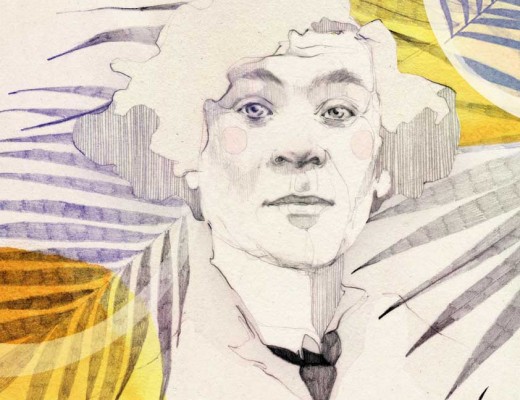Kazimir Malevich is the main representative of the Russian avant-garde and the founder of the radically new art movement, Suprematism. It is in fact a countermovement to conventional art, which for Malevich is nothing more than clinging on to a dead moment. In his essay “From Cubism and Futurism to Suprematism” Malevich explores the new painterly realism and introduces the Suprematist Manifesto. He liberates art from objectivism and academism, and turns perception into its absolute centre. The masterpiece of Suprematism is the Black Square.
With a special exhibition in the context of the Great Berlin Art Exhibition at Lehrter Bahnhof in 1927, Kazimir Malevich delighted the audience with his presence. We met him on a warm summer evening at a dinner party hosted by a friend in his honour. I had the opportunity to talk to the master about art.
A. M.:
Mister Malevich, how do you like being here in Berlin?
K. M.:
Berlin is wonderful. Everything seems to be possible in this moment here. Something is in the air. People are hungry for new things. I think it is the only place on earth where new art can occur. I intend to live here for some time. Berlinograd (smiles) feels like home to me and I feel very honoured to be invited here for an exhibition.
A. M.:
I recently had the opportunity to read your essay on Suprematism. It is brave to break the rules of conventional art, suggesting something new, without ignoring ethical principles at the same time. Your Manifesto is ground-breaking…
K. M.:
Thank you for your kindness. How did you come to read my essay as people usually only encounter my art work?
A. M.:
Your paintings and essays are penned by you, I am interested in both and try to understand the radical forms of aesthetics you take in their whole. How can you know if they will ever be accepted by the audience?
K. M.:
There is one thing you should always remember: As an artist you never ask, if you can do this or that, you radically do what there is to do and what is on your mind. The audience is obligated to deal with it because it exists. It is a matter of time for the audience, but not for art. Art is infinite and timeless. Creating, and not recreating, is our shared destiny, therefore you are a philosopher and I am an artist.
A. M.:
What is the reason for denying conventional art? Don’t you think it’s rather an arrogant attitude –
K. M.:
Arrogant towards whom?
A. M.:
Towards other artists.
K. M.:
No. Conventional art is pure arrogance towards God and demonstrates peoples demoralized state of mind. The frame of a painting is a prison to that subject of life you see on it. In truth there is nothing but dead moments or simply death. With the same reason humans keep caged animals to understand their nature, not to mention other atrocities against humans and nature. I want freedom for art and therefore for the whole nature.
A. M.:
How is it possible to follow you, without the reference to a general term of art?
K. M.:
Say goodbye to the art you know, for it is nothing but imitation and never-ending repetition of things, which already exist in perfection in nature. There is no way and there is no genius to bring those things on canvas in a better form as they do have in their natural environment. Light, for example… Do you really think there could ever be someone who would paint light as the light you see, when you open your eyes? It is simply impossible. As an artist you can’t compete with God, it is arrogant even ever to think of it. Everything you find in art, already exist in nature, which is Gods supreme art work. An artist, who only imitates and recreates a dead moment as a piece of “infinite art”, must be considered as failed.
A. M.:
You have something completely new on your mind, what we don’t know yet like the earth which did not exist until it began to exist.
K. M.:
Exactly.
A. M.:
Don’t get me wrong, but don’t you think there is no humbleness in your aesthetic theory towards God?
K. M.:
Not at all. You see, humankind was created in the likeness of God and is featured with certain attributes, which means, that we also can create and do modestly our duty. The difference between God and humans is that God is absolute and we, humans, can achieve this absolutism only in our minds and through transformation of immateriality into materiality.
A. M.:
So, you suggest Suprematism, which is the theory of the highest, to approach this idea of God in art. What is the highest and which technique can be applied to achieve it in reality?
K. M.:
The highest is pure spirit and pure perception, which is nothing else but God. It can be achieved, when art is non-objective and perceptive. Things must be radically separated from material appearance through abstraction until you get pure forms, such as square, circle, infinity sign, triangle and cross. In the same time things get not only separated from appearance, but also from dimensionality and you get a simple surface to apply colour, which is in the case for the “Black Square”, for instance.
A. M.:
We see a black square in front of a white background. It is the opposition of infinity, represented by white colour an and fugacity, which is represented by black. In “Black Square” you unite all things, which pass with time and exist in our world. You succeed to catch the dynamics of life. When you get a close look on it you realize – the black is not black, and the white is not white. The viewer recognizes texture and structure and gets the feeling that there is movement in the painting. This peace is radical. No other artist will ever dare to create anything comparable without being rebuked as an imitator. How can the “Black Square” in the sense of Suprematism ever be increased? The only way I see is to frame a white canvas that is not white. Why did you take black?
K. M.:
In my aesthetics, the colour black has nothing to do with the banal idea of mourning that always accompanies it. Black is the colour of all colours in their purest concentration. Highly concentrated red, as well as highly concentrated green or blue, evidently look black until diluted or further processed.
Furthermore, it is not the question of whether, how and by whom the “Black Square” can be surpassed, but much more, which equivalences to this still hover undetected in the ether and whether they can ever be discovered. The white canvas is not a bad idea, you should continue to work on this theory. I would read it with pleasure.
A. M.:
I’ll send you my manuscript as soon as I finish it …
All possibilities of the material and the immaterial are summarized in the formula of the “Black Square” in matters of the perception of the visual. What would the “Black Square” be in terms of music, if we follow the logics of Suprematism?
K. M.:
Nothing but silence.
The conversation was conducted in Russian and took place at a dinner party in honour of Kazimir Malevich during the Great Berlin Art Exhibition at Lehrter Bahnhof, which concluded in August 1927. Unfortunately, Mr. Malevich had to leave Berlin without his paintings on an order of the Soviet government for reasons unknown and probably won’t have the opportunity to come back ever again.





No Comments